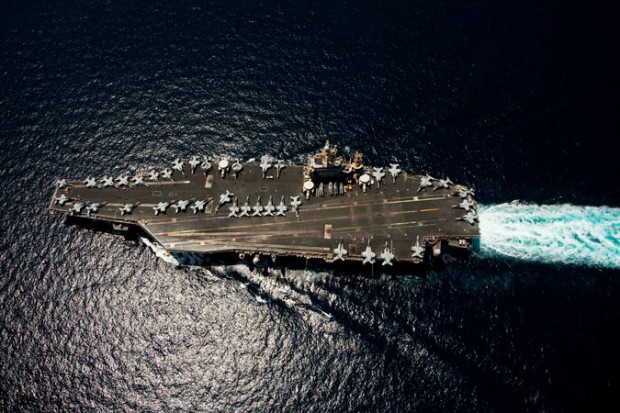
The Nimitz-class aircraft carrier U.S.S. Abraham Lincoln in April 2012. Iran is building a mock-up in one of its shipyards
Unrelated stories about Iran, Israel and art have come up three times in an art context over the course of two days. That’s unusual here at AFC so I’ve taken the liberty of bundling a few reflections into a post.
UNDER CONTEMPORARY ART’S VITRINE
File this piece under long reads (or short academic reads). Artist and writer Gelare Khoshgozaran describes her invitation to show her work in an exhibition in Tel Aviv as an “invitation for [her] “identity” to be exhibited in the vitrine of cultural tourism by means of “art”. About a month later she visits “The Iranian Modern Art” exhibition at NYU, which coincided with “Iran Modern” at Asia Society and doesn’t like what she sees.
Exhibitions such as Iran Modern, which reduce Iran to the binary “glorious pre-Islamic Republic” versus the “oppressed post-revolutionary,” are part of a larger neocolonial attitude granting Iran legitimacy through modernity. The desire to be legible to the western subject is at the core of this exhibitionism and (over)exposure. Documentary practices of photography and fictional short or feature films where the brown subject is a “representative”—both depicting and delegating—for the eyes of the white Western “art and culture lover,” contribute to this desire. The responsibility of the pedagogical brown is to be willing to educate the western white enthusiast. Hence there is always going to be a documentary about “gays in Iran,” a TedTalk about “Iranian Contemporary Art,” an NPR story about underground rock in Iran and an exhibition “about contemporary art from Iran and Syria”.
Khoshgozaran’s observations felt true, but they also left me wondering about how much education the western white enthusiast really wants. Yesterday I visited a student’s studio at SVA who was making non-functioning art guns for children. Bits of translucent blue plastic were affixed to one of the guns with a stapler for ammunition. Another had a tank full of marshmallows, while an adjacent gun, spray painted silver, looked like a cross between a canon and a telescope. The student had a lot of family in Israel, and this, I was told, somehow informed what he was doing.
Sending kids a message that violence is a high-minded way of solving problems is the kind of cultural response I don’t care to be educated in, though I suppose there’s something to be said for work that doesn’t painfully hue to a politically correct message. I’m not sure what that is, though, which I find troubling.
IRANIAN SHIP LOOKS FAMILIAR TO U.S.
Identity politics may be less complicated when they are simply being replicated. Yesterday, the New York Times reported that US officials believed a trompe l’oil mock-up of an American nuclear-powered aircraft carrier would be blown up in Iran purely for propaganda purposes. That same day, I received an email imploring me to write about the subject as it was surely an art story. After all, the replica doesn’t function, it’s shrouded in mystery, and is yet intended to communicate a message over, say, completing a specific task. It’s an immerse and conceptual (by which I mean only that thought and strategy has played a part in its making).
Valid points, but I can’t bring myself to do more than point out a similarity in language. I’m more comfortable with art serving no purpose in the political power games that lead to war. Part of that stance comes from the belief that during times of extreme duress our energies better spent elsewhere. Perhaps more urgently though, I just don’t want to participate.


Comments on this entry are closed.